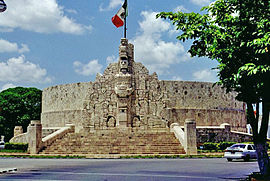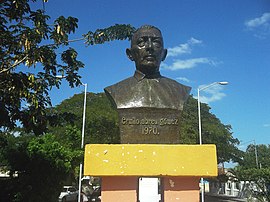Mérida (Mexico)
| Merida | ||
|---|---|---|
|
Coordinates: 20 ° 58 ′ N , 89 ° 37 ′ W Merida on the map of Yucatán
|
||
| Basic data | ||
| Country | Mexico | |
| State | Yucatan | |
| Municipio | Merida | |
| City foundation | 1542 | |
| Residents | 830,732 (2017) | |
| - in the metropolitan area | 1,035,238 | |
| City insignia | ||
| Detailed data | ||
| height | 9 m | |
| Post Code | 97000 | |
| prefix | (+52) 999 | |
| Time zone | UTC −6 | |
| City Presidency | Mauricio Vila Dosal (2015-2018) | |
| Website | ||
| Paseo de Montejo | ||
| Mérida Town Hall | ||
| Ermilo Abreu Gómez, writer, describes revolts of the oppressed Maya; Bust in Mérida | ||
Mérida (in modern Mayathan Ho , from ho ' "five") is the capital of the Mexican state of Yucatán . In terms of tourism, Mérida is considered to be the gateway to the Maya world ( Puerta al Mundo Maya ).
With a population of around 800,000, Mérida is one of the fifteen largest cities in Mexico. Over a million people live in its metropolitan area, the Zona Metropolitana de Mérida . Mérida is the administrative seat of the Municipio Mérida and the seat of the Archdiocese of Yucatán .
history
Pre-Hispanic City
In place of today's Mérida, there was a large settlement since the Middle Preclassic , which reached its peak in and after the Middle Classical. It was characterized by large and high pyramid-like platforms, on the upper surface of which there were probably buildings from the late classical period. The Franciscan Diego de Landa and later bishop described the buildings as magnificent and also included a drawing. The largest structure, the temple pyramid Baklu'mchan with a side length of about 120 m and about 10 m high, was later converted into a Franciscan monastery and then into the fortress of San Benito. Today the central market "Mercado Municipal Lucas de Gálvez" is located on their premises. Modern studies have been able to pinpoint the location of other pre-Hispanic buildings. So the probably largest building was located opposite the cathedral, another, which was called "Cerro de San Antón" in colonial times, with the dimensions 180 × 120 m, was located east of San Benito. Other smaller complexes have been identified on the basis of old sources, height measurements and geo-radar investigations. Overall, the pre-Hispanic Ti'ho 'was as important as Chichén Itzá , Uxmal and Izamal . The latter place with its numerous large and small pyramid platforms can give an impression of what Ti'ho 'might have looked like.
Colonial city
The old Mayan city of Ti'ho ' ("to five") was renamed Mérida on January 6, 1542 by Francisco de Montejo the Younger. The name of the city refers to the Spanish city of Mérida , because of its huge Roman remains, which the Spaniards were reminded of in view of the equally magnificent pre-Hispanic buildings. Here as there, however, the old buildings were often used as quarries for the construction of the Spanish city, which in Mérida led to its complete disappearance by the beginning of the 20th century. Montejo settled a small number of Spanish families in Mérida. Already in 1618 the city had its first own theater and in 1735 today's town hall was built.
Modern city
The core city of Mérida has around 800,000 inhabitants. Orientation is easy thanks to the grid-like road system typical of Latin American cities. Streets with even numbers run from north to south, the odd ones from east to west, the numbering increases from north to south or from east to west. Roads 61 and 60 run north and west of the cathedral.
politics
Town twinning
Mérida has fourteen twin cities :
| city | country | since | status |
|---|---|---|---|
| Camaguey |
|
2000 | inactive |
| Chiquinquirá |
|
1999 | inactive |
| Cozumel |
|
2010 | active |
| Erie |
|
1973 | inactive |
| Glendora |
|
1973 | inactive |
| Iguala |
|
2009 | inactive |
| Incheon |
|
2007 | active |
| Manzanares |
|
2000 | inactive |
| Merida |
|
1990 | inactive |
| Merida |
|
1990 | inactive |
| Miami |
|
2011 | active |
| New Orleans |
|
1990 | active |
| Panama City |
|
2003 | inactive |
| Pereira |
|
2000 | inactive |
| Sarasota |
|
2010 | active |
Culture
Important places and streets
The former Zócalo is now called Plaza de la Independencia ( Plaza Grande ) and is the lively center of Merida. On the east side is the double-towered cathedral, which was built between 1561 and 1598 . It was built by hundreds of Mayan workers, the most important building material being stones from the previously destroyed temples of the ancient Mayan city of Ti'ho '. Inside is the Cristo de la Unidad (Christ of Unity). The huge figure of Christ crucified is the symbol of the reconciliation between the descendants of the Spaniards and the Maya. The Museo de Arte Contemporáneo Ateneo de Yucatan is located south of the cathedral in the former bishop's palace . It contains important works by local artists and consolidates Mérida's reputation as the culturally richest city on the Yucatáns Peninsula. On the south side of the Plaza de la Independencia is the Casa de Montejo from 1549 . The former palace of the Montejo family with its figured portal is now the seat of a bank.
On the west side of the plaza is the white Palacio Municipal (City Hall). It was created in 1735 . In 1821 the independence of the state of Yucatán was proclaimed from the veranda on the first floor. The northern side of the square is occupied by the Palacio de Gobierno (Governor's Palace), the inner courtyard of which is decorated with murals by Fernando Castro Pacheco on the history of the Yucatán.
To the north of the Plaza de la Independencia ( Plaza Grande ) is the Parque Hidalgo , which is adjacent to the Iglesia de Jesús , built by the Jesuits in 1618 as part of a monastery. This church, too, was essentially built from the material of demolished temples. The Spanish occupiers made sure that no ornaments from the Maya period were preserved. However, remnants of the original decorations can be seen on two stones on the outer facade.
The wide boulevard Paseo Montejo in the north of the city center with its numerous villas from the 19th century is reminiscent of the Paseo de la Reforma in Mexico City or the Champs-Élysées in Paris , according to the wishes of the city planners . This is where the Palacio Cantón is located , the stately residence of General Francisco Cantón Rosados, which today houses the Museo de Antropología e Historia .
Events
- The street festival Mérida en Domingo (Mérida on Sunday) takes place every Sunday in the Plaza de la Independencia area . The city center becomes a large pedestrian zone with cabaret, live music and snack bars.
- From late September to mid-October Cristo de las Ampollas , where Gremios celebrate the Christ of the Blisters in a daily procession.
- Carnaval , which is considered the largest and most magnificent of the Yucatán Peninsula.
- Teatro Peón Contreras , the largest theater on the Yucatán Peninsula, with performances and concerts almost daily.
particularities
Some shops and markets in and around Mérida sell maquech : live beetles that are worn by locals as jewelry.
sons and daughters of the town
- Juan José de Vértiz y Salcedo (1719–1799), Spanish politician and viceroy of the Río de la Plata during the Spanish colonial rule in Argentina
- Andrés Quintana Roo (1787–1851), politician
- Pablo Castellanos León (1860–1929), pianist and music teacher
- Antonio Mediz Bolio (1884–1957), playwright, poet, journalist and politician
- Carlos Torre Repetto (1905–1978), chess player
- Pierre Vidal (1906–1967), entrepreneur and politician in French West Africa
- Antonio Magaña Esquivel (1909–1987), literary scholar, writer, film director, journalist and essayist
- Augusto H. Álvarez (1914–1995), architect
- José Antonio Zorrilla (1915–1985), composer, writer, screenwriter and director
- Nicolás Urcelay (1919–1959), singer
- Rolando Arjona Amábilis (1920–2014), artist and university professor
- Roberto Casellas Leal (1922–2018), ambassador
- Manuel Barbachano Ponce (1925–1994), director, screenwriter and film producer
- Carlos Iturralde Rivero (1926-2004), football player
- Armando Manzanero (* 1935), musician, singer and composer
- Mario Renato Menéndez Rodríguez (* 1937), journalist and publisher
- Miguel Canto (* 1948), flyweight boxer
- Guty Espadas (* 1954), flyweight boxer
- Freddy Castillo (* 1955), flyweight and light flyweight boxer
- José Rafael Palma Capetillo (* 1955), Roman Catholic auxiliary bishop in Jalapa
- Jorge Rodríguez-Novelo (* 1955), Roman Catholic auxiliary bishop in Denver
- Beatriz Zavala Peniche (* 1957), politician
- Juan Herrera (* 1958), flyweight boxer
- Jorge Carlos Patrón Wong (* 1958), Roman Catholic clergyman, Archbishop of the Curia
- Luis Carrasco (* 1963), skeleton driver
- Guty Espadas junior (born 1974), boxer
- Guadalupe Worbis (born 1983), football player
- León de Castillo (* 1985), Austro-Mexican tenor, conceptual artist, music researcher and artistic director
- William Paredes (born 1985), football player
- Rommel Pacheco (* 1986), water diver
- Marcel Ruiz (* 2000), football player
Climate table
| Merida | ||||||||||||||||||||||||||||||||||||||||||||||||
|---|---|---|---|---|---|---|---|---|---|---|---|---|---|---|---|---|---|---|---|---|---|---|---|---|---|---|---|---|---|---|---|---|---|---|---|---|---|---|---|---|---|---|---|---|---|---|---|---|
| Climate diagram | ||||||||||||||||||||||||||||||||||||||||||||||||
| ||||||||||||||||||||||||||||||||||||||||||||||||
|
Average monthly temperatures and rainfall for Merida
Source: WMO ; wetterkontor.de
|
|||||||||||||||||||||||||||||||||||||||||||||||||||||||||||||||||||||||||||||||||||||||||||||||||||||||||||||||||||||||||||||||||||||||||||||||||||||||||||||||||||||||||||||||||||||||||||||||||||
Web links
- Homepage of Mérida (span.)
- Diario de Yucatan, daily newspaper from Mérida (span.)
- History and culture of Mérida in Cosmopolis
- Museums in Mérida and the surrounding area
Individual evidence
- ↑ http://www.merida.gob.mx/negocios/php/meridaennumeros.phpx
- ↑ Joseph Ligorred, Luis Barba: Reencuentro con la Mérida ancestral . In: Arqueología Mexicana 99 (2009) pp. 64-69
- ↑ El Ayuntamiento de Mérida quiere hermanarse con siete ciudades extranjeras. Retrieved September 15, 2015 .







